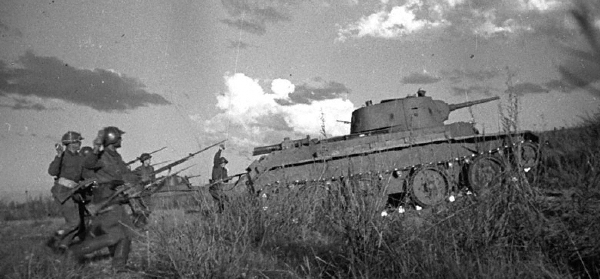
We’ve been talking lately about the Imperial Japanese Army, its rapid entry onto the world stage in the 19th century, and its emphasis on the moral (as opposed to the material) factors of warfare. Note: we are talking here about “morale,” that intangible area of military analysis that makes it so unpredictable and non-scientific. We are not talking about “morality,” the impulse to do the right thing and to fight for righteousness.
The point is that this was an army willing to turn itself into “human bullets” in the service of the emperor. Willing to kill, yes, but even more than that, willing to die. Eager to die. A cold eye towards death was the Japanese army’s great equalizer, a means by which it could beat the odds and overcome its better armed and richer adversaries. Armed with courage and a contempt for its own casualties, it could operate outside the political and economic limits that tend to limit modern armies.
All well and good, perhaps, but there was a downside to it. A Japanese army operating beyond politics could be a dangerous institution, not only for its enemies, but also for Japan itself. In the period between the two world wars, this “army of will” increasingly came to identify its own desires with those of the nation as a whole. It began to dictate policy, rather than follow it. Japan’s highly aggressive field-grade officers—those stationed abroad or in contact with foreign armies—were the real culprits. Again and again in the interwar era, they were a source of trouble. They fired on Chinese forces and civilians at Jinan in 1927 (during the “Second Shandong Expedition”), unilaterally decided to overrun Manchuria in August 1931, and precipitated the “Shanghai incident” in 1932, which led to bloody fighting with the Chinese army and a great deal of international ill-will. In February 1936 they tried to overthrow the government in Tokyo, deeming it insufficiently forceful towards Japan’s foreign enemies. Finally, in July 1937, they fired on Chinese troops at the Marco Polo Bridge outside of Beijing. What started as local fighting spread far and wide and soon grew into a full-scale Sino-Japanese war.
None of this narrative is meant to excuse the government in Tokyo. It, too, felt the lure of the siren: the notion that boldness and a stronger will and a refusal to accept second-class status could somehow overcome strategic weakness. The Japanese army may have gone rogue, launching one unauthorized attack after another, but the government retroactively approved every move. It was by now an article of faith among all of them that Japan could only compete with the West if it had access to the resources of China and Southeast Asia. Emperor Hirohito, often regarded as a retraining influence or even as some sort of pacifist (an absurd notion, given the historical record), was the worst offender. He knew that Japan’s unruly military was a useful tool in solidifying his power at home and expanding it abroad. Restraining influence? More like the opposite.
For all its usefulness as a weapon of Japanese statecraft in the 1930s, however, a rogue army is rarely a good idea. The conquest of the immense, resource-rich province of Manchuria is a good example. While it looked good on paper, it also created a vulnerable Japanese enclave with an ill-defined boundary meandering some 3,000 miles against a resurgent Soviet Union still seeking revenge for the defeat of 1904–05. Frontier disputes in the region repeatedly flared up into skirmishes in the 1930s, with neither side willing to display weakness or back down.
One such encounter took place along the Khalka river (“Khalkin-Gol” in Russian), and it should have been a wake-up call to Hirohito and his minions in Tokyo. Some typical back-and-forth shoving across the indefinite border led both sides to send reinforcements. Finally, the Soviets launched a full-scale counterattack spearheaded by hundreds of tanks. Conceived by a figure who wasn’t very famous at the time (but soon would be), General G. K. Zhukov, the operation featured two widely separated armored thrusts that sliced easily through the Japanese flanks. Emphasizing fighting spirit rather than firepower, the Japanese had no real answer to Zhukov. Within days, the Soviet pincers had linked up far behind the lines at Nomonhan, encircling and destroying an entire Japanese infantry division (the 23rd). It was a fiasco for an army that until now been fattening up on poorly armed and trained Chinese levies. Suddenly, morale-based concepts like will and bayonet charges and Yamato-damashii seemed a lot less important than material factors like firepower and armor thickness and main gun caliber.
The disaster at Khalkin-gol took place in August 1939. Is it possible, even two years before Pearl Harbor, that the Japanese Army had already lost World War II?
As for that rogue army? You can keep it.
For the latest in military history from World War II‘s sister publications visit HistoryNet.com.




